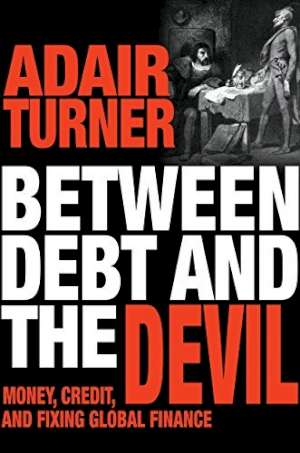01 February 2016
Between Debt and the Devil: Money, Credit and Fixing Global Finance
Adair Turner
2015, Princeton University Press, 320 pages,
ISBN ASIN: B00WY4OWL8
Reviewer: Ian Mulheirn, Director of Consulting, Oxford Economics

Some books are compelling because of what they say, others because of who is saying it. Adair Turner’s Between Debt and the Devil is both.
Turner took the helm at the Financial Services Authority just five days after Lehman Brothers went bust, and over the intervening years has played central roles in reforming financial regulation, both in the UK and internationally. No radical, Turner is the insider’s insider. All the more reason we should take his iconoclastic tract seriously. The book ranges widely across the boundaries of finance and macroeconomics. This puts it in a rare category of contributions to the debate that recognizes the lessons we should learn in both spheres.
Turner begins by highlighting the twin failures of the pre-crisis orthodoxy. First that, provided inflation targeting achieved low and stable inflation, the amount of leverage had no implications for macroeconomic stability. Second that moving closer to ‘complete’ financial markets through hyperactive financial innovation would inevitably improve price discovery and hence allocative efficiency.
Both of these assumptions were woefully wide of the mark. Turner shows how credit is overwhelmingly directed to the purchase of existing housing, rather than investment in new productive assets. This allowed a dangerous debt bubble to emerge that barely registered on the dashboards of macroeconomic policymakers. And financial innovation, far from facilitating price discovery, in fact exacerbated information asymmetries. Rather than risk being distributed to those best placed to manage it, opaque securities ensured that was instead shovelled on to those least able to understand it.
Without radical change, Turner argues persuasively, credit creation and direction by the free market will always tend to be excessive, directed to unproductive ends, and ultimately destabilizing.
Turner is ambivalent about credit’s role in driving growth before 2007. The large majority of it, he argues, was channelled into the purchase of existing assets – particularly housing – adding nothing directly to nominal GDP and hence did not show up clearly in the inflation figures. But on the other hand he argues that rising inequality, particularly in the US, led many to seek to protect their living standards through unsustainable secured borrowing against houses. Whatever he really thinks about the relationship between rapid credit growth and economic performance before 2008, he lays blame for the anaemic recovery across Europe and the US squarely at the door of the debt overhang that followed the crash. We faced, and still face, a so-called ‘balance sheet recession’ in which households and firms devote their income to servicing and paying down their debts, sapping aggregate demand.
Some of his prescriptions for prevention next time are familiar: much higher capital requirements and the reintroduction of reserve asset ratios for banks; tighter regulation of shadow banking; maximum loan-to-income and loan-to-value ratios for homebuyers. But he makes a cogent case for government interventions such as infrastructure banks, to push against the market’s tendency to direct a socially sub-optimal amount of credit to property. Given the importance he attaches to inequality as a driver of financial instability, Turner’s ideas here – higher minimum wages and minimum incomes – seem thin. His suggestion of international coordination to limit current-account imbalances is surely right, but he remains vague on the path to that destination.
But it is Turner’s prescription for overt money finance that goes well beyond what would hitherto have passed for polite conversation among economists. He argues that governments should create fiat money to boost nominal GDP growth and lift their economies out of the debt mire: Milton Friedman’s helicopter money solution. Balanced throughout, Turner recognises that this is not without risks. Would governments, taking this step in a crisis, acquire a taste for monetary finance of public deficits in normal times, leading to inflationary and wasteful public spending? The answer surely depends on whether we have the right institutions in place to manage it appropriately.
And arguably we already do. The alternative to helicopter money is to continue trying to stimulate private credit creation using the tools that major central banks have been using for the past seven years. Unconventional monetary policies like quantitative easing were themselves made politically viable by the trend towards independent central banking in the 1990s and 2000s. Central bank independence took the control over private credit creation out of the hands of finance ministers, precisely to stop them abusing it for electoral advantage. So it’s hard to see why the same framework, with central banks specifying the quantity of money to be created, would not be equal to the task of wielding the money finance bazooka responsibly.
Some have argued that proposals for helicopter money aren’t nearly as radical as they seem. Money finance, it can be argued, is formally equivalent to quantitative easing combined with a higher inflation target. But if there is one point that Turner rams home in his tract, it is that people don’t operate with the perfect foresight and rational expectations of homo economicus. Public perceptions of and responses to these alternatives are likely to be very different, as is their political viability. It would be ironic if the suspect axioms of the pre-crisis orthodoxy led one to see Turner’s big idea as nothing more than a higher inflation target.
For most, Turner’s radical prescriptions will be too much. The financial system is undoubtedly less vulnerable than it was, and our understanding of its role and the risks it presents is far more nuanced than it was in 2007. But if the trend of the past 35 years towards financial instability continues, it may only be a matter of time before we’re back here again. Perhaps then Turner’s book will be the blueprint policymakers will turn to.
